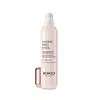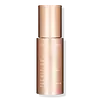What's inside
What's inside
 Key Ingredients
Key Ingredients

 Benefits
Benefits

 Concerns
Concerns

 Ingredients Side-by-side
Ingredients Side-by-side

Water
Skin ConditioningButylene Glycol
HumectantGlyceryl Stearate
EmollientHelianthus Annuus Seed Oil
EmollientPEG-100 Stearate
Glycerin
HumectantBehenyl Alcohol
EmollientEthylhexyl Palmitate
EmollientSimmondsia Chinensis Seed Oil
EmollientNiacinamide
SmoothingAcacia Senegal Gum
MaskingCaprylyl Glycol
EmollientPhenoxyethanol
PreservativeCaffeine
Skin ConditioningCarnitine Hcl
HumectantMica
Cosmetic ColorantCetearyl Alcohol
EmollientCarbomer
Emulsion StabilisingEthylhexylglycerin
Skin ConditioningAllantoin
Skin ConditioningHexylene Glycol
EmulsifyingSodium Hydroxide
BufferingHydrolyzed Rhizobian Gum
Potassium Behenoyl Hydroxyproline
AntioxidantDisodium EDTA
Pentadecalactone
MaskingSodium Hyaluronate
HumectantTocopherol
AntioxidantBehenic Acid
CleansingGlycine Soja Oil
EmollientPortulaca Oleracea Extract
Skin ConditioningTin Oxide
AbrasiveCapsicum Annuum Leaf Extract
Skin ConditioningRosa Centifolia Flower Extract
AstringentNicotiana Sylvestris Leaf Cell Culture
Skin ConditioningCI 77891
Cosmetic ColorantWater, Butylene Glycol, Glyceryl Stearate, Helianthus Annuus Seed Oil, PEG-100 Stearate, Glycerin, Behenyl Alcohol, Ethylhexyl Palmitate, Simmondsia Chinensis Seed Oil, Niacinamide, Acacia Senegal Gum, Caprylyl Glycol, Phenoxyethanol, Caffeine, Carnitine Hcl, Mica, Cetearyl Alcohol, Carbomer, Ethylhexylglycerin, Allantoin, Hexylene Glycol, Sodium Hydroxide, Hydrolyzed Rhizobian Gum, Potassium Behenoyl Hydroxyproline, Disodium EDTA, Pentadecalactone, Sodium Hyaluronate, Tocopherol, Behenic Acid, Glycine Soja Oil, Portulaca Oleracea Extract, Tin Oxide, Capsicum Annuum Leaf Extract, Rosa Centifolia Flower Extract, Nicotiana Sylvestris Leaf Cell Culture, CI 77891
Water
Skin ConditioningDimethicone
EmollientGlycerin
HumectantIsononyl Isononanoate
EmollientBetaine
HumectantCetearyl Alcohol
EmollientDicaprylyl Carbonate
EmollientCI 77891
Cosmetic ColorantCellulose
AbsorbentGlyceryl Stearate
EmollientPEG-100 Stearate
Prunus Amygdalus Dulcis Oil
Skin ConditioningStearoxymethicone/Dimethicone Copolymer
EmollientSynthetic Fluorphlogopite
Albizia Julibrissin Bark Extract
MaskingCaffeine
Skin ConditioningCetearyl Glucoside
EmulsifyingSodium Polyacrylate
AbsorbentAnigozanthos Flavidus Extract
Skin ConditioningCaprylyl Glycol
EmollientEthylhexylglycerin
Skin ConditioningParfum
MaskingTocopheryl Acetate
AntioxidantAcrylates/C10-30 Alkyl Acrylate Crosspolymer
Emulsion StabilisingAvena Sativa Kernel Extract
AbrasiveDisodium EDTA
Escin
TonicDimethiconol
EmollientButylene Glycol
HumectantSorbitol
HumectantTocopherol
AntioxidantMarrubium Vulgare Extract
Skin ConditioningSodium Hydroxide
BufferingTin Oxide
AbrasiveSodium Benzoate
MaskingMitracarpus Scaber Extract
Skin ConditioningCapsicum Annuum Fruit Extract
AntimicrobialPhenethyl Alcohol
MaskingFurcellaria Lumbricalis Extract
Skin ConditioningHelianthus Annuus Seed Oil
EmollientLapsana Communis Flower/Leaf/Stem Extract
Skin ConditioningMaris Sal
Skin ConditioningRosmarinus Officinalis Leaf Extract
AntimicrobialWater, Dimethicone, Glycerin, Isononyl Isononanoate, Betaine, Cetearyl Alcohol, Dicaprylyl Carbonate, CI 77891, Cellulose, Glyceryl Stearate, PEG-100 Stearate, Prunus Amygdalus Dulcis Oil, Stearoxymethicone/Dimethicone Copolymer, Synthetic Fluorphlogopite, Albizia Julibrissin Bark Extract, Caffeine, Cetearyl Glucoside, Sodium Polyacrylate, Anigozanthos Flavidus Extract, Caprylyl Glycol, Ethylhexylglycerin, Parfum, Tocopheryl Acetate, Acrylates/C10-30 Alkyl Acrylate Crosspolymer, Avena Sativa Kernel Extract, Disodium EDTA, Escin, Dimethiconol, Butylene Glycol, Sorbitol, Tocopherol, Marrubium Vulgare Extract, Sodium Hydroxide, Tin Oxide, Sodium Benzoate, Mitracarpus Scaber Extract, Capsicum Annuum Fruit Extract, Phenethyl Alcohol, Furcellaria Lumbricalis Extract, Helianthus Annuus Seed Oil, Lapsana Communis Flower/Leaf/Stem Extract, Maris Sal, Rosmarinus Officinalis Leaf Extract
Ingredients Explained
These ingredients are found in both products.
Ingredients higher up in an ingredient list are typically present in a larger amount.
Butylene Glycol (or BG) is used within cosmetic products for a few different reasons:
Overall, Butylene Glycol is a safe and well-rounded ingredient that works well with other ingredients.
Though this ingredient works well with most skin types, some people with sensitive skin may experience a reaction such as allergic rashes, closed comedones, or itchiness.
Learn more about Butylene GlycolCaffeine is most associated with coffee, tea, and cacao. In skincare, it helps with calming inflammation and is rich in antioxidants.
While caffeine is used to treat cellulite and and dark circles, further studies are needed to prove this. It has been believed to help with these skin conditions due to its ability to dilate blood vessels and increase blood flow.
Some studies are looking into caffeine's ability to protect against UV rays.
Learn more about CaffeineCaprylyl Glycol is a humectant and emollient, meaning it attracts and preserves moisture.
It is a common ingredient in many products, especially those designed to hydrate skin. The primary benefits are retaining moisture, skin softening, and promoting a healthy skin barrier.
Though Caprylyl Glycol is an alcohol derived from fatty acids, it is not the kind that can dry out skin.
This ingredient is also used as a preservative to extend the life of products. It has slight antimicrobial properties.
Learn more about Caprylyl GlycolCetearyl alcohol is a mixture of two fatty alcohols: cetyl alcohol and stearyl alcohol. It is mainly used as an emulsifier. Emulsifiers help prevent the separation of oils and products. Due to its composition, it can also be used to thicken a product or help create foam.
Cetearyl alcohol is an emollient. Emollients help soothe and hydrate the skin by trapping moisture.
Studies show Cetearyl alcohol is non-toxic and non-irritating. The FDA allows products labeled "alcohol-free" to have fatty alcohols.
This ingredient is usually derived from plant oils such as palm, vegetable, or coconut oils. There is debate on whether this ingredient will cause acne.
Due to the fatty acid base, this ingredient may not be Malassezia folliculitis safe.
Learn more about Cetearyl AlcoholCi 77891 is a white pigment from Titanium dioxide. It is naturally found in minerals such as rutile and ilmenite.
It's main function is to add a white color to cosmetics. It can also be mixed with other colors to create different shades.
Ci 77891 is commonly found in sunscreens due to its ability to block UV rays.
Learn more about CI 77891Disodium EDTA plays a role in making products more stable by aiding other preservatives.
It is a chelating agent, meaning it neutralizes metal ions that may be found in a product.
Disodium EDTA is a salt of edetic acid and is found to be safe in cosmetic ingredients.
Learn more about Disodium EDTAEthylhexylglycerin (we can't pronounce this either) is commonly used as a preservative and skin softener. It is derived from glyceryl.
You might see Ethylhexylglycerin often paired with other preservatives such as phenoxyethanol. Ethylhexylglycerin has been found to increase the effectiveness of these other preservatives.
Glycerin is already naturally found in your skin. It helps moisturize and protect your skin.
A study from 2016 found glycerin to be more effective as a humectant than AHAs and hyaluronic acid.
As a humectant, it helps the skin stay hydrated by pulling moisture to your skin. The low molecular weight of glycerin allows it to pull moisture into the deeper layers of your skin.
Hydrated skin improves your skin barrier; Your skin barrier helps protect against irritants and bacteria.
Glycerin has also been found to have antimicrobial and antiviral properties. Due to these properties, glycerin is often used in wound and burn treatments.
In cosmetics, glycerin is usually derived from plants such as soybean or palm. However, it can also be sourced from animals, such as tallow or animal fat.
This ingredient is organic, colorless, odorless, and non-toxic.
Glycerin is the name for this ingredient in American English. British English uses Glycerol/Glycerine.
Learn more about GlycerinGlyceryl Stearate is a mix of glycerin and stearic acid.
It is used to stabilize the mixing of water and oil ingredients. By preventing these ingredients from separating, it can help elongate shelf life. It can also help thicken the product's texture.
As an emollient, it helps soften skin and supports barrier-replenishing ingredients.
In cosmetics, Glyceryl Stearate is often made from vegetable oils or synthetically produced.
This ingredient may not be fungal-acne safe
Fun fact: The human body also creates Glyceryl Stearate naturally.
Learn more about Glyceryl StearateHelianthus Annuus Seed Oil is the oil derived from the seeds of a Sunflower. Sunflower seed oil is non-fragrant. It is an emollient, meaning it helps to soften the skin.
Sunflower seed oil contains many fatty acids. The fatty acids found in sunflower seeds include (from highest amount to least): linoleic acid, myristic acid, palmitic acid, stearic acid, arachidic acid, oleic acid, and linolenic acid.
These fatty acids help the skin create ceramides. Ceramides play a role in repairing the skin barrier.
Helianthus Annuus Seed Oil helps moisturize the skin. This in turn helps the skin look more rejuvenated and smoother.
Sunflowers are rich in vitamin E.
Historians believe Indigenous cultures of North America domesticated sunflowers before corn. Thus they relied on sunflower oil for a variety of uses. One such use is moisturizing skin and hair.
Sunflower seed oil may not be fungal acne safe. We recommend speaking with a professional if you have any concerns.
Learn more about Helianthus Annuus Seed OilPeg-100 Stearate is an emollient and emulsifier. As an emollient, it helps keep skin soft by trapping moisture in. On the other hand, emulsifiers help prevent oil and water from separating in a product.
PEGS are a hydrophilic polyether compound . There are 100 ethylene oxide monomers in Peg-100 Stearate. Peg-100 Stearate is polyethylene glycol ester of stearic acid.
Sodium Hydroxide is also known as lye or caustic soda. It is used to adjust the pH of products; many ingredients require a specific pH to be effective.
In small amounts, sodium hydroxide is considered safe to use. However, large amounts may cause chemical burns due to its high alkaline.
Your skin has a natural pH and acid mantle. This acid mantle helps prevent harmful bacteria from breaking through. The acid mantle also helps keep your skin hydrated.
"Alkaline" refers to a high pH level. A low pH level would be considered acidic.
Learn more about Sodium HydroxideTin Oxide is an inorganic oxide used to add opacity and volume to a product. In nature, it is already found in mineral form. The main ore of tin is an opaque and shiny mineral called casseterite.
Tin Oxide helps remove translucency in a product, or make it more opaque. Besides adding opacity, tin oxide is used for bulking to add volume.
Tocopherol (also known as Vitamin E) is a common antioxidant used to help protect the skin from free-radicals and strengthen the skin barrier. It's also fat soluble - this means our skin is great at absorbing it.
Vitamin E also helps keep your natural skin lipids healthy. Your lipid skin barrier naturally consists of lipids, ceramides, and fatty acids. Vitamin E offers extra protection for your skin’s lipid barrier, keeping your skin healthy and nourished.
Another benefit is a bit of UV protection. Vitamin E helps reduce the damage caused by UVB rays. (It should not replace your sunscreen). Combining it with Vitamin C can decrease sunburned cells and hyperpigmentation after UV exposure.
You might have noticed Vitamin E + C often paired together. This is because it is great at stabilizing Vitamin C. Using the two together helps increase the effectiveness of both ingredients.
There are often claims that Vitamin E can reduce/prevent scarring, but these claims haven't been confirmed by scientific research.
Learn more about TocopherolWater. It's the most common cosmetic ingredient of all. You'll usually see it at the top of ingredient lists, meaning that it makes up the largest part of the product.
So why is it so popular? Water most often acts as a solvent - this means that it helps dissolve other ingredients into the formulation.
You'll also recognize water as that liquid we all need to stay alive. If you see this, drink a glass of water. Stay hydrated!
Learn more about Water